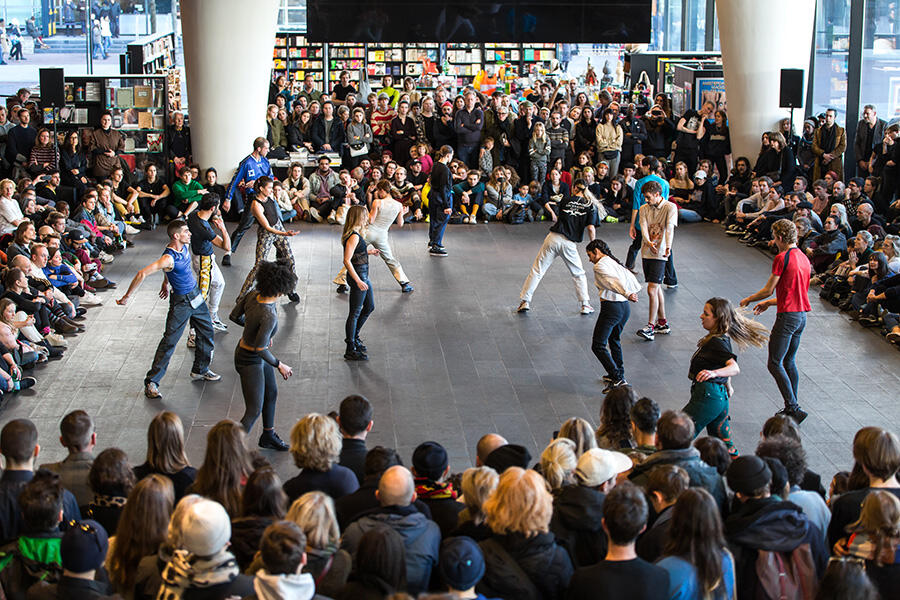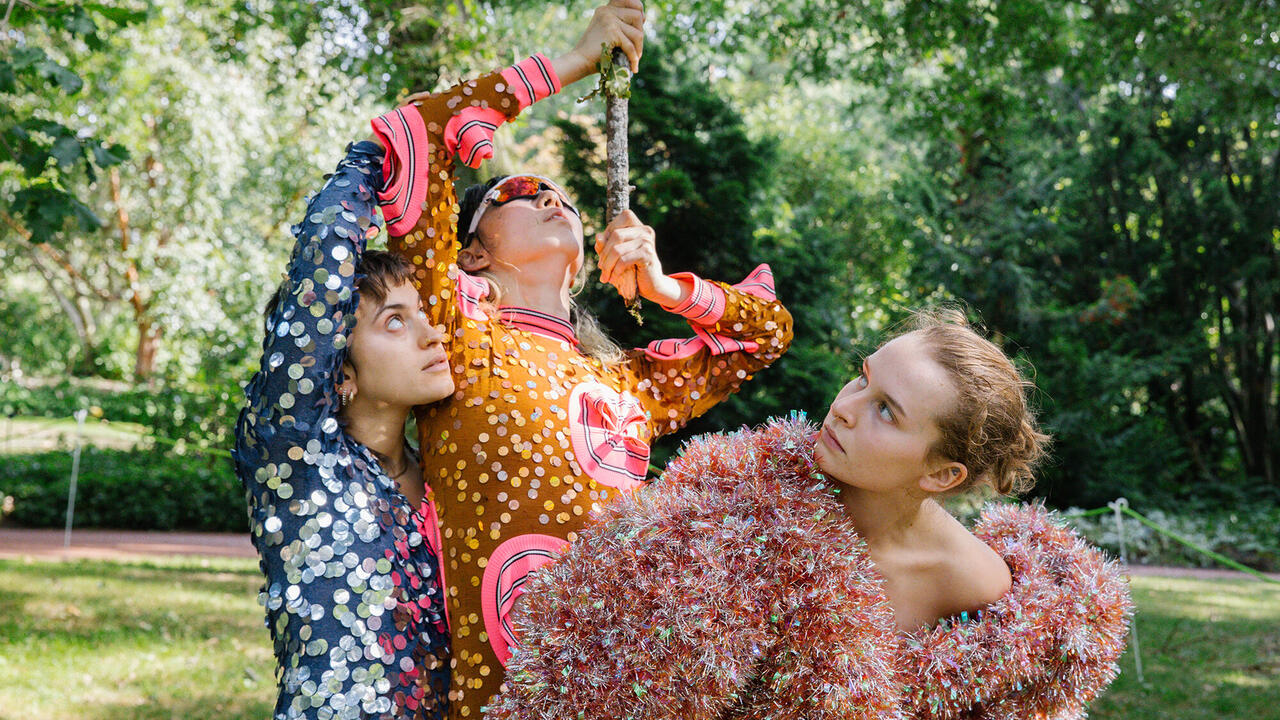Choreographer Michele Rizzo Reveals the Ecstasy and Unredeemed Power of the Nightclub
At Amsterdam’s Stedelijk Museum, Rizzo’s performance ‘Higher.xtn’ unpicks the communal politics of the dance floor
At Amsterdam’s Stedelijk Museum, Rizzo’s performance ‘Higher.xtn’ unpicks the communal politics of the dance floor

4/4, a siren calls. We wait. Slow-steady, young ravers descend upon the lobby: from the left, then the right, then behind. Clad in second-hand sports brands, well-worn workwear and sundry leatherettes, they serve the leftovers of last night’s looks. Yet their movements are introverted, their gazes downcast. Once onstage, they shuffle about aimlessly as they sync up to Lorenzo Senni’s haunting synths. Casually self-absorbed, they seem oblivious to anyone but themselves. By the time the music shifts gears towards a slower beat, the dancers have settled into rows facing each other and move in perfect unison.
Slowly but surely the pace of Michele Rizzo’s Higher.xtn (2018) picks up. Even as they begin striding boldly across the stage and swapping positions, their synchrony never falters. They hardly even glance at each other. Eventually, the chills hit. It feels impossible to describe the visceral effect given by these endlessly repeated movements in tandem. Yet this is precisely the appeal – because it is something that anyone who has ever danced innately understands; because it is like sex. As the dance hurdles towards its climax, those timid small-town steps yield wholeheartedly to the self-assured abandon of big-city queens: knees bent deep, arms flung wide, all drenched in sweat. They leave in fours or pairs, then one by one. When the music’s gone, piercing whistles and the occasional scream are the only sounds you can make out through the applause.

Higher.xtn comes as the latest instalment in an ongoing movement research project that choreographer and artist Michele Rizzo initiated in 2015. After studying at the School for New Dance Development and the Sandberg Instituut in Amsterdam, Rizzo went on to produce the first version of Higher in collaboration with the Frascati Theatre and ICK Amsterdam. Originally developed for a classic black box theatre, the earliest version featured an extended light show and only three dancers – Rizzo himself alongside Juan Pablo Camara and Max Goran. Later on, the project came to encompass a series of large public workshops. These workshops in turn helped Rizzo refine the techniques he would use to drill the cadre of dancers at the Stedelijk into ecstatic unison. One exercise, for example, involved pairing the dancers off and having them improvise over extended periods while staring into their partner’s eyes. This was designed to help the dancers lose their bodily self-consciousness in the face of the other. Only then would another exercise start introducing the piece’s short yet precise phrases into these durational improvisations, step by step. And though some dancers understandably described the marathon rehearsals as rewarding but exhausting, the characteristically authorial Rizzo was more reserved: ‘…you know, it was only two weeks.’

Performed twice a week over the course of a month as part of the exhibition Freedom of Movement, Higher.xtn quickly grew into considerable social media success. It now seems that Rizzo is well poised to join the growing number of choreographers working as frequently in museums as they do in theatres and festivals. But compared to the languidly immersive performance environments of Maria Hassabi, Anne Imhof or Adam Linder, Highert.xtn stands out for its assertive theatricality: an unambiguous stage, a clearly defined beginning and end, relentless synchronisation, and a rejection of all things ‘participatory.’ On the phone, however, Rizzo conceded that this sense of theatricality was partly an unintended consequence of the piece’s runaway success. During the first performances, visitors were somewhat confused when they initially encountered the dancers awkwardly shuffling to themselves in the stairwells and halls; some even wanted to join. This ambiguity, Rizzo suggests, would probably have been more in line with the way people perceive things with their bodies as they wander through an exhibition space. By the last performance, even visitors who’d come half an hour early found themselves jostling for a place to stand, let alone sit, in the Stedelijk’s crowded lobby, and you could feel the anticipation swell with every minute the stage was empty. The audience had arrived and they wanted a show.

But beyond these translations between museum and theatre, there is something more sacred at work: the translation between the experience of clubbing and its representation. The image offered is, paradoxically, one of private transcendence in the midst of complete social determination. In the pursuit of ecstasy, the dancers submit wholeheartedly to each other and more importantly, to the rhythm that holds them in step.
In an early statement on the piece, Rizzo speaks of trusting in dance as ‘the practice that compensate[s] for the fact that we can never be each other,’ and thus ‘we attempt in becoming one.’ What Rizzo shows us is an inverted technology of the self: one where discipline does not serve to cultivate the individual, but rather dissolves it altogether. He shows us the individual body ventriloquised in the service of something greater than itself. But the question remains: in service of what? Here, the vision of transcendence doubles as a vision of community. Much like protests, night clubs and festivals are one of the few forms of IRL assembly still tolerated as a pressure valve to daily life under capital. Unlike protests, though, these assemblies are meticulously guarded spaces, blissfully free of social conflict and subsequently dialogue: bouncers over barricades, community over class. At its most powerful, Rizzo’s Higher.xtn not only shows us the ecstasy of social communion, but also its glaringly unredeemed potential. Being together is beautiful, just as long as it’s not with everyone.
Michele Rizzo’s Higher.xtn was performed in January and February at Amsterdam’s Stedelijk Museum, as part of the exhibition ‘Freedom of Movement’, which runs until 17 March 2019. His new piece Deposition premiered at Kunstencentrum Buda, Kortrijk, Belgium, on 20 February. On 1 March, Rizzo will hold a workshop at the Stedelijk Museum.
Main image: Michele Rizzo, Higher xtn., 2018, performance documentation. Courtesy: the artist and Stedelijk Museum, Amsterdam; photograph: Maarten Nauw



















